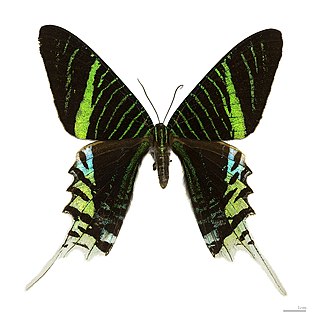
The Uraniidae are a family of moths containing four subfamilies, 90 genera, and roughly 700 species. The family is distributed throughout the tropics of the Americas, Africa and Indo-Australia. Some of the tropical species are known for their bright, butterfly-like colors and are called sunset moths. Such moths are apparently toxic and the bright colors are a warning to predators.
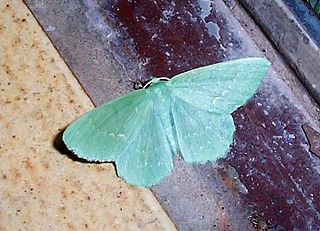
The Geometroidea are the superfamily of geometrid moths in the order Lepidoptera. It includes the families Geometridae, Uraniidae, Epicopeiidae, Sematuridae, and Pseudobistonidae. The Geometroidea superfamily has more than 24,000 described species, making them one of the largest superfamilies inside the order Lepidoptera. The monotypic genus Apoprogones was considered a separate geometroid family of the Apoprogonidae by a minority, but is now subsumed under the Sematuridae.
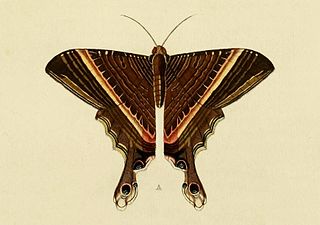
Sematuridae is a family of moths in the lepidopteran order that contains two subfamilies.
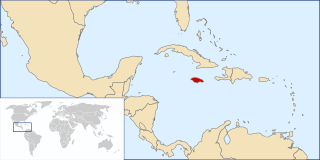
Urania sloanus, or Sloane's urania, was a species of moth of the family Uraniidae endemic to Jamaica. It was last reported in 1894 or 1895, but possibly survived until at least 1908. The species was first described by Pieter Cramer in 1779.

Lyssa zampa, the tropical swallowtail moth or Laos brown butterfly, is a moth of the family Uraniidae. The species was first described by British entomologist Arthur Gardiner Butler in 1869.

Urania leilus, the green-banded urania, is a day-flying moth of the family Uraniidae. The species was first described by Carl Linnaeus in his 1758 10th edition of Systema Naturae. It is found in tropical South America east of the Andes, especially in the Amazon rainforest. Its range includes Suriname, Guyana, French Guiana, eastern Colombia, Venezuela, eastern Ecuador, Brazil, northern Bolivia, eastern Peru, as well as the island of Trinidad. It has been recorded as a vagrant to the central and northern Lesser Antilles, such as St. Kitts, Barbados and Dominica. Their preferred habitat consists of riverbanks, in primary and secondary rainforest, at elevations between sea level and about 800 m (2,600 ft).

Alcides metaurus or North Queensland Day Moth is a moth of the family Uraniidae. It is known from the tropical north of Queensland, Australia.
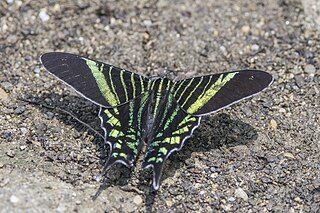
Urania fulgens, the urania swallowtail moth or green page moth, is a day-flying moth of the family Uraniidae. The species was first described by Francis Walker in 1854. It is found from Veracruz, Mexico, through Central America to northwestern South America. It is highly migratory and has been recorded as a vagrant to the US state of Texas.

Oroplema plagifera is a moth of the family Uraniidae first described by Arthur Gardiner Butler in 1881. It is found on the Korean Peninsula and in Japan, eastern China, Russia (Sakhalin), Taiwan and northern India.

Oroplema oyamana is a species of moth of the family Uraniidae. It is found in Korea, Japan, Taiwan, northern India, Nepal, Borneo and the Philippines (Luzon).
William Warren was an English entomologist who specialised in Lepidoptera.

Urania boisduvalii is a day-flying moth of the family Uraniidae. It was first described by Félix Édouard Guérin-Méneville in 1829. A genetic analysis of Urania moths gave rise to a phylogenetic tree which places U. boisduvalii as sister to the in-group that includes U. fulgens spp. poeyi, U. fulgens, U. sloanus, U. sloanus, U. leilus and U. leilus spp. brasiliensis.
Urania poeyi is a day-flying moth of the family Uraniidae.

Urania brasiliensis is a day-flying moth of the family Uraniidae first described by William John Swainson in 1833.

Eversmannia exornata is a species of moth, belonging to the family Uraniidae. The species was described in 1837 by Eduard Friedrich Eversmann as Idaea exornata. It is native to Eastern Europe. The species has also been found within Western Siberia, as far east as the Altai Krai. This is the only moth within the Uraniidae family known to inhabit the West of Palearctic.
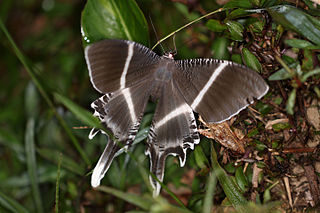
Lyssa menoetius is a moth of the family Uraniidae. The species was first described by German entomologist Hopffer in 1856.













